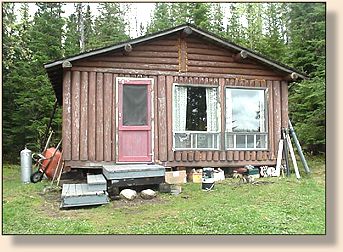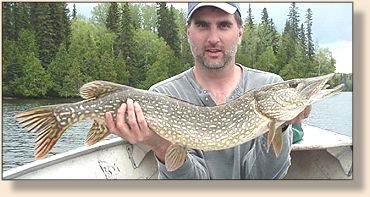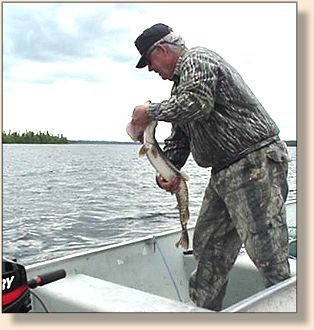For Patton it was Rommel; for Ali, Fraiser. Sherlock Holmes had
his Morieriety. In many ways adversaries define our effort. Sure, it's
a stretch to think of flyfishing as art imitating life. Especially when your
adversary is a northern pike. But if we were to really consider the
ESOX as a worthy adversary, what would it take?
Obviously, a worthy flyfishing adversary should readily take a fly. Readily
would qualify as serious understatement for pike…how about voraciously?
They should live in pristine, wild environs…like one's you fly in to…with
wild moose swimming the lake. They should fight well…a small runaway
freight train comes to mind.
If you ever look in the cockpit of an American Airlines B-777, you might see
Marc Batway. In a previous life Marc and I flew meaner looking jets in far
away places. In addition to flying the triple-seven, he's the architect, builder
and host of a pretty spiffy deer camp (maybe an even better grouse camp)
in the Upper Peninsula of Michigan. And he and his Dad run a camp in
central Michigan guiding for the limited Michigan elk hunt. He was the
orchestrator of this year's venture north for pike just after ice-out. He
put together a compatible group of reprobates, made all the arrangements,
even succeeded in scheduling some beautiful weather.
 Our trip began at the "Propwash," Marc's aforementioned deer camp.
A day's drive north from the UP, through Sault Saint Marie to Hornepayne,
Ontario we boarded DeHaviland L-20 "Beavers" on floats for the flight into
Little Caby lake and a hand hewn log cabin…our home and headquarters
for the next week.
Our trip began at the "Propwash," Marc's aforementioned deer camp.
A day's drive north from the UP, through Sault Saint Marie to Hornepayne,
Ontario we boarded DeHaviland L-20 "Beavers" on floats for the flight into
Little Caby lake and a hand hewn log cabin…our home and headquarters
for the next week.
It was the 16th of April and the last of the ice had given up only two weeks
before. Just a few days before our arrival it had snowed enough to cover the
ground and delay the inevitable mosquito and black fly hatch. No bugs for
almost a week in springtime Canada was a piece of luck you can't count on.
At least as grateful for this brief respite from clouds of bugs were quite a number
of moose. They're much faster swimmers than your average old dude from
north Florida would think.
Flights of migrating waterfowl joined us at Caby, the "wash" from their wings
audible from more than a mile away as they completed steep, fast decent from
the high altitude structure of migration. Loons that I might have watched fishing
Pensacola Bay just a few weeks before were pairing up at Caby, singing to
each other, giving us the evening serenade no trip to Canada is complete without.
After dark, and once the aurora borealis calmed down,
we studied a night sky with the North Star much higher than we're used to.

In this explosion of life that follows the darkness and bitter cold of an
Ontario winter the piscatorial residents are not exempt. The northern
pike make their move from deep water to the shallows of the northernmost
coves as the water warms. They end up on the first small drop in depth
of these coves that will soon choke with reeds and grass. We think they're
looking for love but we know they're hungry. Ravenous comes to mind.
Not much is very subtle about these barracudas of the north at this time
of the year.
I had tied up some pretty nondescript streamers in red/yellow, red/white/,
and white/yellow synthetics. Synthetics last a little longer than natural materials
after a few attacks from these toothy critters. These streamers were four
to six inches long and I tied them on 1/0 hooks. Sparse ties were easier to
cast but I couldn't prove the fish cared one iota. Most of the streamers
included a loop of 20-pound hard Mason to make them weedless. I also
had a few large (1/0) popping bugs crafted of foam and synthetics. All
my poppers were destroyed by the second evening. (Note to self: bring
more poppers next year.) The new "knotable" BON wire leader material
in twenty to thirty pound test turned out to be very bueno. Four to six inches
of it with a Homer Rhodes loop knot to the fly and a perfection loop to three
feet of twenty "four-turn blood knotted" to six feet of thirty worked just fine.
These guys are not leader shy. But man are they toothy! At the end of
the week my hands were a mess.
The preferred technique seemed to be, "See a fish, cast the fly where the fish
could see it, make two or three hard strips, then just hang on." Most of the
time sight fishing was the order, and the strike was almost always visible, but
sometimes a hungry intruder would grab the offering from right in front of the
target. With the poppers the pike sometimes launched into the air to come
down on top of a gurgling offering; sometimes they came up from below the
popper and a good strip-set would turn them half a somersault. Usually a
large wake would just appear headed toward the popper, and then a two-foot
hole would open in the surface of the water. Even 15-pound specimens don't
often get to your backing but they jump, run very fast for short distances and
are still making 30 foot runs after ten minutes. They throw water, weeds, and
mud in every direction and they always look so very angry!
 We brought eight weight outfits on this trip. These, quite frankly left us on the
borderline of "under-gunned." The eights were fine for five to eight pounders
but when one of those ten to 15 pound guys loaded up, you were wishing you
had a bigger rod. Next year I'm bringing ten weights as well. A mid-flex nine
weight might be best if you only bring one size. Weight forward floating lines
worked very well, though we didn't try any dredging in deep water. We found
it better to fish for walleyes or just hang around camp most days until the sun
got on the water. And the catch for a day that it rained all day long was
significantly lighter. (Walleye for the larder is not a bad diversion.)
We brought eight weight outfits on this trip. These, quite frankly left us on the
borderline of "under-gunned." The eights were fine for five to eight pounders
but when one of those ten to 15 pound guys loaded up, you were wishing you
had a bigger rod. Next year I'm bringing ten weights as well. A mid-flex nine
weight might be best if you only bring one size. Weight forward floating lines
worked very well, though we didn't try any dredging in deep water. We found
it better to fish for walleyes or just hang around camp most days until the sun
got on the water. And the catch for a day that it rained all day long was
significantly lighter. (Walleye for the larder is not a bad diversion.)
In retrospect, I'm thinkin' you'd be hard pressed to find an adversary that
took you to more beautiful surroundings then challenged your skill and
rewarded hard work any more. As for me, I'll take ice-out pike fishing
any day.
Getting there:
Olivier's Fly-In Camps, Hornepayne, Ontario, Canada, operates quite a
number of fly-in camps that vary from rustic to the "American Plan." Their
year around number is 800-868-2337. Olivier's uses Horne Air as their
charter service.
Flies:

Hook: 1/0 VARIVAS 990 Carbon or substitute (3407s work fine).
Thread: Flat waxed nylon, red or orange.
Weed guard: 20# Hard Mason mono.
Wing: A mix of White or Yellow
Kinky Hair and silver or gold Flashabou.
Collar: : Red Kinky hair.
~ Hugh Smith
|



